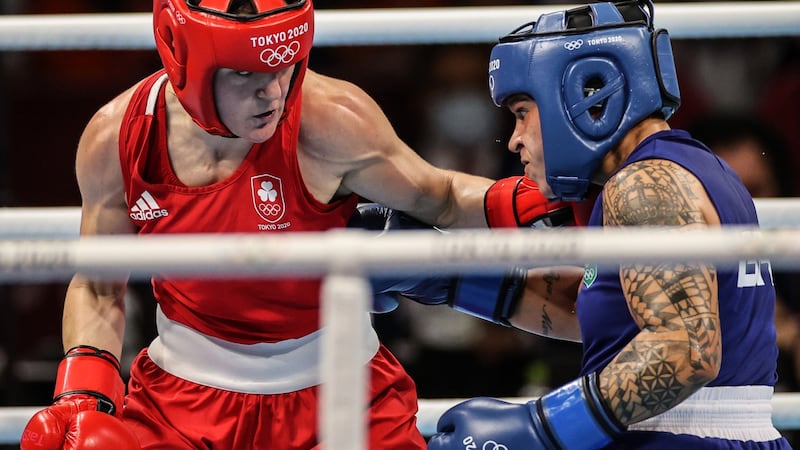It doesn’t take too far a look back in time to find a popularly shared Irish male view that women shouldn’t box.
Reasons ranged from bodies not being made for it, those ‘pretty’ faces being broken up, to the unedifying spectacle of torsos and contents being pummelled.
It isn’t that people dislike boxing, although many do. It is that they dislike women boxing. Virtually all of it intolerant and discriminatory from a sport that has really just come out of the stone age, it’s layered with pseudoscience, lads making it up as they go along, telling athletes what they should or shouldn’t do in their spare time.
There is no real scholarship to back up the bar stool positions other than what the Sweet Science has always faced. That is, being punched on the head and body many times is not always good for various parts, male or female.
But for women, sport has rarely been permissive; a space where they were at first tolerated then pigeon-holed a niche pursuit. When Katie Taylor was two-years-old in 1988, a total of 8,391 athletes attended the Seoul Olympic Games, the first Olympics of her life.
From that total, the number of males attending was 6,197 athletes, the female number was just over a third at 2,194 athletes.
Historically, women in track and field have always had to compete at different distances and in different events for no reason whatsoever. In athletics, women including Sonia O’Sullivan, ran over 3,000m until this was matched to the men’s 5,000m event in 1996. Male overseers, in their wisdom, decided that 5K was just too long a distance for a woman’s body to tolerate. No science.
Similarly, women competed in a 10km race walk in 1992 and 1996 before this was changed to the standard men’s distance of 20km.
The expansion of the women’s athletics programme was glacially slow. The triple jump was added in 1996, the hammer and pole vault in 2000 and the steeplechase in 2008. All are events in which women can ably participate and excel.

Women’s basketball was not added to the summer Olympic roster until 1976, women’s hockey came in 1980, cycling in 1984. Badminton arrived in 1992, soccer in 1996, water polo graced the Millennium games in 2000 before boxing landed in the London docklands in 2012.
Boxing’s addition combined with the decision by the IOC to drop baseball meant that in London women competed in every sport at a summer Games for the first time since its modern version began in 1896.
London also marked the first time that all national Olympic committees sent a female athlete to the Games. Brunei, Saudi Arabia and Qatar, all entirely misrepresenting how they viewed female sport in their own country, nonetheless had female athletes as a part of their delegations.
Now, just short of a decade after London put women's boxing on the map by staging three weight divisions (the lads, at the time, wanted them to wear skirts because "it gives a good impression, a womanly impression"), two women, Taylor and Kellie Harrington have emerged, not just the brightest names in Irish boxing but two of the biggest names in the world in their sport. Jockey Rachael Blackmore has also stepped on to that stage.
Quite the turnaround. Both Taylor and Harrington struggled to participate in the sport, Taylor told she couldn’t fight against boys, Harrington told there were no clubs for young female boxers.
Both women became world champions, Taylor for the first of five times as an amateur in 2006, Harrington in 2018. Both became Olympic champions, Taylor in 2012, Harrington in 2021 with Taylor turning professional in 2016 and becoming the undisputed lightweight world champion.
For almost as long as the sport has existed, female boxing has been effectively outlawed with athletic commissioners refusing to sanction or issue fight licenses to women and many nations officially banning the sport.
The British Boxing Board of Control did not grant women licences to fight competitively until the late 1990s, having previously denied them on the grounds that premenstrual syndrome made competitors unstable.
We have moved on. But in 2021 it is still not over, the fight for fair ground, the pithy, intransigent doctrinaires, the miserable fight for inches, parity and the years of playing catch up with male counterparts, who have always under estimated strength of character and athletic worth.
For Harrington and other women boxers, there is still no World Championships organised for this year, while the male equivalent are settled for Belgrade. For Taylor, while she has voiced her opinion that she would prefer to fight in three-minute rounds like men do, the governing body insists on the shorter distance. Taylor is still running Sonia's 3,000m event, while the men are running 5,000m.
“Definitely if you had three-minute rounds you would have a better chance of stopping these girls for sure,” said Taylor in her first full year as a professional. “It does make for a different fight as well. We spar three-minute rounds all the time. I’m happy to go three-minute rounds.
Maybe that's how officialdom likes it, no stoppage female boxing. If we can't have skirts we'll have it knock-out free. How ironic the last month has been, Ireland having two global stars, who in the atrophied minds of some don't know how to throw a proper jab.












